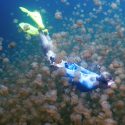Every 75 years, a ball of fire streaks across the sky. But that’s no fireball. It’s Halley’s Comet. And you’re about to hitch a ride on it. Get ready for a journey around the Sun to the edge of the Solar System. And back again. What conditions would you find there? How would you manage to survive on your new icy home? And what would it have in common with a trip to a Hawaiian island?
Comets are the frozen remnants of our Solar System’s formation from about 4.6 billion years ago. They’re made up of dust, rock and ice. And they come in many sizes, shapes and levels of notoriety. Maybe the most famous is Halley’s Comet, officially known as 1P/Halley. It’s been observed for over 2,000 years. It was the first comet that astronomers understood would make repeat visits.
More specifically, it was astronomer Edmond Halley who figured this out back in the 18th century. Based on his calculations, we know the comet returns to our night sky just about every 75 years. With its last flyby past Earth happening back in 1986, you can expect to see it again in 2061. Plenty of time for you to get ready to hitch a ride on an icy rock. But beware.
You wouldn’t come back to Earth until the year 2136. When you catch your ride aboard Halley’s Comet, you wouldn’t be the first mission to land on a comet. In 2004, the European Space Agency began the Rosetta mission to follow a comet in its orbit around the Sun. 10 years later, they were able to successfully deploy a lander on the comet’s surface. But you would be the first to make a human-crewed rendezvous with a comet.
As your spaceship was closing in on Halley’s Comet, the first thing you’d encounter would be large amounts of gas and dust. Somebody get a housecleaner over here. This gas and dust combo form an atmosphere that stretches behind the comet for millions of kilometers. The particles of dust would be tiny, only one-millionth the size of a smoke particle. And while you’d be protected inside your spaceship, this would certainly make your approach to the comet a little more challenging.
The dust particles would slam against the shield of your ship at about 241,400 km/h (150,000 mph). Keep your fingers crossed that they wouldn’t rip off chunks of your craft like they did to one unlucky space probe back in 1986. If they did, it could threaten the entire mission. You could temporarily lose control of your ship, not to mention contact with Earth.
Needless to say, with about 60 tons of dust flying off the comet every second, you’d be in for a wild ride. But you’d finally land successfully on the comet’s nucleus, which looks like a potato or an unshelled peanut. It’s here you’d be met with a big surprise. First of all, a comet’s nucleus is what’s left of it after you strip away all the dust and gas. And the nucleus of this particular comet has a total surface area that is similar in size to the Hawaiian island of Lanai.
So while you’d be traveling solo on your mission, you could have brought along plenty of friends and family. Well, maybe next time. But you’d be in for another surprise too. While you could have imagined that something made of ice would be white and bright, you’d find the surface more like an incredibly dirty snowball. That’s thanks to a thick layer of dust that is blacker than coal.
This makes Halley’s Comet one of the least reflective objects in the Solar System. It only reflects about 3% of the light that falls on it. As you began to explore your surroundings, you’d want to make sure to do so with extreme caution. The surface gravity would be far too low for you to walk around freely. If you jumped as high as you’d do on Earth, you would leap right off into space.
Hopefully, you didn’t imagine bouncing on a trampoline on your journey around the Solar System. That doesn’t mean there’s still not a chance you could accidentally get bounced off anyway. While we don’t know exactly how fast Halley’s Comet rotates on its axis, there would be a period of transition from day to night. The safest thing for you would be to stay on the nightside as much as you can.
As you already know from your hazardous approach, the comet is heated by the Sun. As it heats up, the gas and dust particles are ejected off its surface. And they could take you with them. You’d better buckle your seat belt because the closer you get to the Sun, the faster you’d be traveling. Rounding this first destination on your trip you’d be moving at about 196,000 km/h (122,000 mph).
Hopefully you’d be equipping your spacecraft with a good temperature regulator. Thanks to the heat-absorbing powers of that dusty black surface, temperatures on Halley’s Comet would reach a blistering 87 °C (189 °F). But as you head further away from the Sun, things would become cooler and cooler. Traveling past Mars, the gas giants and ice giants into the Kuiper Belt, you’d eventually have to deal with temperatures as low as -220 °C (-364 °F).
If you planned to stay alive for the duration of your trip, you’d need equipment to make breathable air and drinking water from the comet’s water ice supply. To keep everything up and running, you could harvest electricity from the kinetic energy of the comet itself. Remember your journey is long. More than 75 years. And as you reach the edges of our Solar System, you’d also slow way down.
Here, you’d be practically crawling at only 3,200 km/h (2,000 mph). And now as you begin the long journey back to Earth, you’d catch a front-row glimpse at how Halley’s Comet is falling apart. With every loop it makes, it loses somewhere between 1 to 3 m (3 to 10 ft) of material.
Scientists estimate that comets can survive a maximum of 1,000 trips around the Sun. But with 16,000 years and around 210 revolutions in its current orbit already under its belt, Halley shows no significant signs of aging.
Just don’t invest too much into property on this dark, rocky mass. Eventually, your great-great-great grandchildren could be left with nothing but a crumbling comet being torn apart every second. Instead, you could grab a plot of land on the Moon.
Sources
- “Comets”. 2022. solarsystem.nasa.gov.
- “Halley’s Comet: Facts About The Most Famous Comet”. Elizabeth Howell. 2022. space.com.
- “In Depth | 1P/Halley – NASA Solar System Exploration”. 2022. solarsystem.nasa.gov.
- “Halley’s Comet, Indeed, Has Heart ‘Black As Coal'”. Lee Dye. 1986. latimes.com.
- “Method Of Making Oxygen From Water In Zero Gravity Raises Hope For Long-Distance Space Travel”. Charles W. Dunnill, The Conversation US. 2018. scientificamerican.com.



























